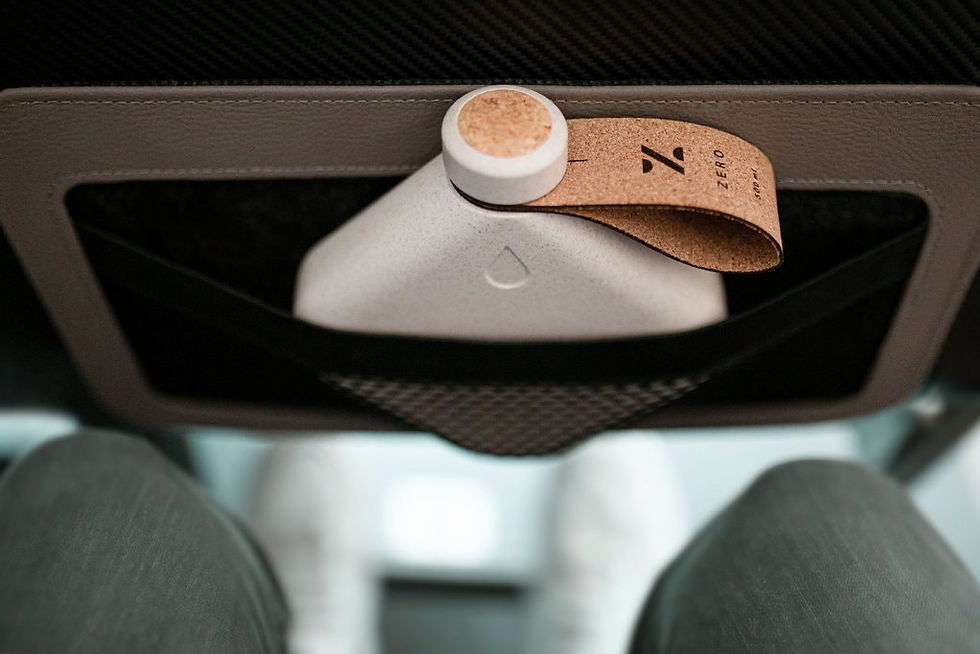SUSTAINABLE MATERIALS, DESIGN AND SUSTAINABLE TRANSPORTATION.
- EvRiM ARıCaN

- Jan 7, 2024
- 3 min read

I would like to share with you a project that I find very successful in our sustainability agenda.
It was exhibited for 6 months last year at The Design Museum in London. u>Priestmangoode's project was launched in October 2019 New York Times reported it. In order to understand why the project is successful, let's take a brief look at the share of the air transportation sector in global pollution.

International air transport association (IATA) according to a global study, airline passengers experience an average of
It produces between 1.43 kg and 2.5 kg of waste. (IATA, 2014).
, a trade group representing approximately 300 airlines. The International Air Transport Association (IATA 2018) conducted a small study at Heathrow Airport in London. As a result of the study, airlines have reported approximately : textColor0;">6.7 million tons cabin waste.
In the same year, the European Parliament >approved the bill banning single-use plastics.
6.7 MILLION TONS OF UNMANAGED CABINET WASTE IN 1 YEAR!
2018' at World Economic Forum,World He warned that there are estimated to be 50 million tonnes of plastic in the oceans, which could take centuries to degrade, and that by 2050 there will be more plastic in the oceans than fish by weight.
50 MILLION TONS OF PLASTIC WASTE IN THE OCEANS!
What fraction of the 6.7 million tonnes of cabin waste might be reaching the oceans?
One can't help but ask: What could we be eating as seafood?
Serious investments are required to separate and recycle cabin waste.
About this Heathrow airport' There is a study conducted by . If everything goes as planned, Heathrow airport will put the conversion system into commercial use in 2025. 100% of cabin waste from incoming and international journeys will be recycled.
An investment that will set an example for all airports.
European union 'Life program' within the scope of 'Zero Cabin Waste' The research has been completed.
According to the statements made by the researchers, airlines do not have systems that can recycle the plastic waste they use. There are no similar systems at airports.
Author of the book “Sustainable Tourism on a Finite Planet” and director of Harvard University's International Sustainable Tourism Initiative According to Megan Epler Wood, neither airlines nor airports have the necessary facilities or systems to manage the transformation of the products they offer to their passengers.
This being the case, it seems that changing the materials used in the industry would be much more constructive, permanent and rational.

In 2019, The Design Museum in London PriestmanGoode company, which took part in the “ Onboard: Reduce.Reuse.Rethink ” exhibition opened in The project made a big impact for these reasons.
The travel meal set, designed entirely with organic materials, seems to be the solution to these problems...The more weight in an aircraft, the higher its fuel emissions. At Priestmangoode, the designs of all elements in the project were developed by taking into account the materials used and their weight.

Food tray: Made from ground coffee waste and husks,
Plates: from compressed wheat bran
Salad cover: from banana peels,
Hot food cover: made of bamboo,
Dessert cover: from waffles
Spoon-fork: made of coconut tree,
inside of the glass: made of seaweed, outside of the glass: made of rice husk,
Sauce packaging: from seaweed
What does this mean?
When you eat your meal on such a tray, you can recycle food waste and containers without the need to separate them.
They undergo transformation together and do not cause carbon emissions during the transformation.



With the water bottle they designed, it is aimed to eliminate the use of disposable water bottles in airports.
All these products designed from organic materials can be composted. In other words, they are 0 carbon in every sense. Products whose existence contributes to the world in a holistic sense, from production to consumption and extinction.
Thus, the design industry offers us a versatile savings.
This is why the right design investments are so important. Information, information, information...
I think we will start to encounter similar products in post-pandemic travel processes. It's really exciting.
At this point, our duty as consumers is to respond to the informative e-mails sent to us by airline companies before our long flights, to inform our eating and drinking preferences, and to prevent more products from becoming waste.
Our expectation from airline companies is that they will make us aware of the sustainability reports they will announce next year with their practices.
Wishing you to stay with love and health,
Evolution Berrak










Comments